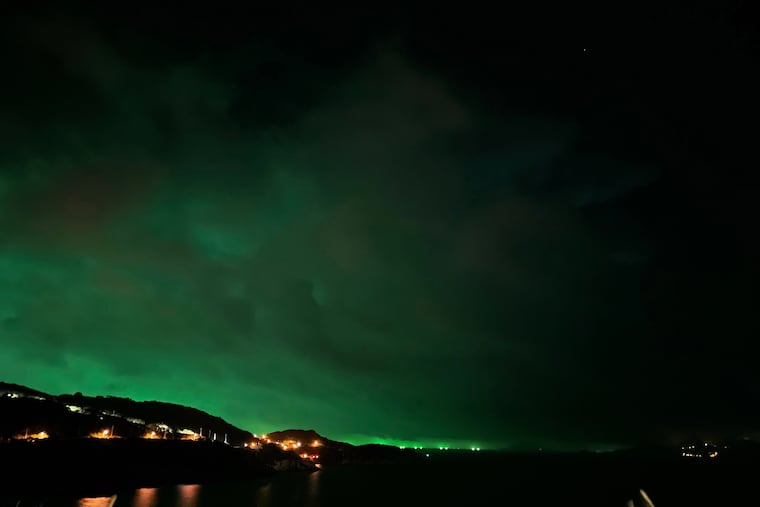A solar storm might make northern lights visible near Philly Saturday night
The solar storm is expected to be a G3 on a scale of 1 to 5. If it's strong enough, the aurora could be visible around here.

A significant solar storm is due to arrive in earth’s outer limits sometime during the day Saturday, and it’s possible that the northern lights become visible in the Philadelphia region after nightfall.
Philadelphia would be close “to the southern edge” of the one-night aurora display — mesmerizing curtains of undulating light appearing in the northern sky — said Bill Murtagh, program coordinator for NOAAs Space Weather Prediction Center.
“We could be seeing the aurora shortly after sunset.”
But he cautioned that when it comes to space weather, his earth-centric counterparts don’t know uncertainty.
“We used to say we’re about 50 years behind the meteorologists,” he said. “I remind the meteorologists, ‘You guys got the first 10 miles. I’ve got the other 93 million.’ ”
» READ MORE: Personal Journey: In search of the Northern Lights
Still Murtagh is confident this storm, or more properly, corona magnetic eruption, will rank as a G3 — on a G1 to G5 scale, “G” for geomagnetic — strong enough to merit a worldwide alert: Along with producing a light show, it could have some impacts on communications and electricity networks.
What are these things?
The storms are bursts of charged particles and magnetic fields streaming from the sun at ultra-high speeds. Murtagh said this one erupted Thursday morning, and his best estimate is that it will arrive around noon Saturday — give or take six hours.
The timing will depend on “the coupling with this earth’s magnetic field,” said Murtagh. He said that if his forecasters predicted that the show would start at 8 p.m. but it actually started six hours later, “We’d consider that a pretty good forecast.”
But, yes, he understands why an aurora-seeking public wouldn’t.
For aurora purposes, later would be better obviously. The undulations can continue for hours, but it’s unlikely that the show would continue Halloween night.
The light show is set off by the interaction of the solar storms and the earth’s magnetosphere. Ordinarily the lights are confined to the polar regions, but particularly strong eruptions can drive them toward midlatitudes.
More to come?
Even if we miss out this time — and the sky-cover forecasts are iffy — more opportunities might follow.
The latest eruption is an indication that the sun is coming to life, after a long lull in “sunspot” activity, Murtagh said. Sunspots result from strong magnetic disturbances in the sun’s interior, and they are associated with increasing numbers of magnetic storms.
“It’s been dead the last few years,” he said. “Now things are picking up.”
» READ MORE: Jupiter's monster storm not just wide but surprisingly deep
With sunspot activity due to approach a peak in 2025, he said, expect more storms, and thus more opportunities for light shows.
The hazards
Severe solar storms can cause serious disruptions to power supplies and to communications networks.
The most famous incident occurred on March 13, 1989, when a G5 storm knocked out a Canadian transformer and left six million people in the dark for nine hours.
A G5 in October 2003 was less disruptive, said Murtagh, but it did cause blackouts in Sweden and South Africa.
Figuring out who is going to be most affected by power or communications issues, he said, is “one of the difficulties.”
Another one, he added, is who is going to get to see the light show.